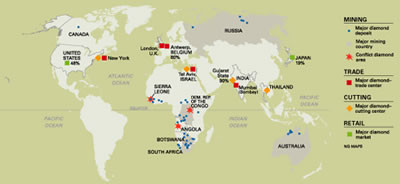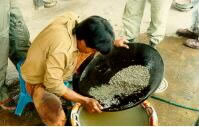 The diamond “invention” (creation of the idea that diamonds are rare and valuable, and are essential signs of esteem) is a relatively recent development in the history of the diamond trade. Until the late nineteenth century, diamonds were found only in a few riverbeds in India and in the jungles of Brazil, and the entire world production of gem diamonds amounted to a few pounds a year.
The diamond “invention” (creation of the idea that diamonds are rare and valuable, and are essential signs of esteem) is a relatively recent development in the history of the diamond trade. Until the late nineteenth century, diamonds were found only in a few riverbeds in India and in the jungles of Brazil, and the entire world production of gem diamonds amounted to a few pounds a year.
In 1870, however, huge diamond mines were discovered near the Orange River, in South Africa, where diamonds were soon being scooped out by the ton. Suddenly, the market was deluged with diamonds. The British financiers who had organized the South African mines quickly realized that their investment was endangered; diamonds had little intrinsic value — and their price depended almost entirely on their scarcity. The financiers feared that when new mines were developed in South Africa, diamonds would become at best only semiprecious gems.
De Beers
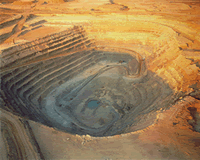 The major investors in the diamond mines realized that they had no alternative but to merge their interests into a single entity that would be powerful enough to control production and perpetuate the illusion of scarcity of diamonds. The instrument they created, in 1888, was called De Beers Consolidated Mines, Ltd., incorporated in South Africa.
The major investors in the diamond mines realized that they had no alternative but to merge their interests into a single entity that would be powerful enough to control production and perpetuate the illusion of scarcity of diamonds. The instrument they created, in 1888, was called De Beers Consolidated Mines, Ltd., incorporated in South Africa.
As De Beers took control of all aspects of the world diamond trade, it assumed many forms. In London, it operated under the innocuous name of the Diamond Trading Company. In Israel, it was known as “The Syndicate.” In Europe, it was called the “C.S.O.” — initials referring to the Central Selling Organization, which was an arm of the Diamond Trading Company. And in central Africa, it disguised its South African origins under subsidiaries with names like Diamond Development Corporation and Mining Services, Inc. At its height — for most of this century — it not only either directly owned or controlled all the diamond mines in southern Africa but also owned diamond trading companies in England, Portugal, Israel, Belgium, Holland, and Switzerland.
By the 1990s, the supply chain had evolved into four stages, two of which are dominated by De Beers as a monopoly controlling the buying of raw diamonds, while the final stages are also strongly influenced by De Beers as the dominant seller:
- Mine Production (46 percent controlled by De Beers)
- Rough Diamond Distribution (80 to 85 percent controlled by De Beers)
- Preparation/Cutting
- Retail Markets (see discussion of De Beers marketing ad)
Since the 1960s, De Beers has been subject to antitrust charges, led by the U.S. Justice Department that it has chosen not to answer in court. As a result, it is prohibited from conducting business in the United States, ironically the largest retail market for the end products it helps to create.
The mechanics of the rough diamond distribution chain are unique to the diamond industry and are the key mechanism used by De Beers to maintain its control over the supply of rough diamonds:
Members of the cartel commit to selling rough diamonds only to dealers of rough gems controlled by the De Beers group.
- Rough diamonds are sorted by De Beers into 5000 categories and divided into ‘boxes.’
- De Beers sets the price and composition of each box in advance.
- Every five weeks, 125 carefully selected partners, known as sightholders, are each invited to view a box and may purchase the whole box at the set price (this ensures that diamonds with less attractive characteristics can be ‘pushed’ into the distribution chain).
- Sightholders may not resell the contents of their boxes to anyone except gem-cutting firms, at risk of losing their privileges to purchase.
Although De Beers controls between 67 percent and 80 percent of the diamonds sold in international markets, most of this control focuses on the upstream portions of the value chain, namely the rough gems. This monopolistic control will be discussed later. It is interesting to note, however, that the arrangement works out for everyone, including the consumer. De Beers limits the supply to dealers, whose disgruntlement is offset by the high profit margins they enjoy, and consumers pay more for an item that arguably is sought after because of its high price. One could argue that diamond consumers want the price of diamonds to stay high, not only to stabilize the value of their own diamond investments but also because of the appeal of being able to afford a luxury good.
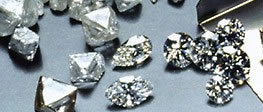 Diamonds are mined in remote areas around the world and are virtually untraceable back to their original sources. These two factors make monitoring diamond trade flow difficult. Additionally, the movement of diamonds from mine to consumers has no set pattern because any single diamond can change hands numerous times, and industry participants often operate on the basis of trust with relatively limited documentation. Such practices are exacerbated by poor data reporting at the country level, where import, export and production statistics often contain inconsistencies. Recently, efforts have been initiated to create a global system of export certification and import verification to ensure that all diamonds that are legitimately imported and exported into diamond-cutting, -trading, and -consuming nations will be of known and verifiable origin.
Diamonds are mined in remote areas around the world and are virtually untraceable back to their original sources. These two factors make monitoring diamond trade flow difficult. Additionally, the movement of diamonds from mine to consumers has no set pattern because any single diamond can change hands numerous times, and industry participants often operate on the basis of trust with relatively limited documentation. Such practices are exacerbated by poor data reporting at the country level, where import, export and production statistics often contain inconsistencies. Recently, efforts have been initiated to create a global system of export certification and import verification to ensure that all diamonds that are legitimately imported and exported into diamond-cutting, -trading, and -consuming nations will be of known and verifiable origin.
The diamond trade structure includes both large and small well-organized components as well as many smaller, uncontrolled operations. While De Beers controls a large percentage of the diamond shipments to key trading centers, UN data suggest that more than 100 countries worldwide participate in rough diamond exporting. In the past few years, new sources of rough diamonds from Australia, Russia, Canada and parts of Africa have considerably changed the controlled single-market system in a number of ways.
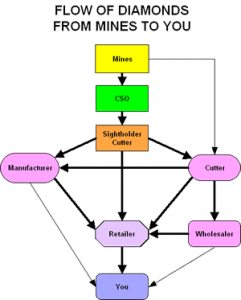 A significant quantity and variety of these “outside” rough diamonds have always been sold on the open market and go directly to a select number of diamond manufacturers in the cutting centers, but strains are showing as the volume of diamonds distributed outside the De Beers cartel grows.
A significant quantity and variety of these “outside” rough diamonds have always been sold on the open market and go directly to a select number of diamond manufacturers in the cutting centers, but strains are showing as the volume of diamonds distributed outside the De Beers cartel grows.
From the cutters, most diamonds flow to the jewelry manufacturers and wholesalers and then on to retailers who sell to the consumer. De Beers has created the consumer demand and then controls the majority of the diamond flow through the Central Selling Organization (CSO).
Changes in Industry Structure
De Beers owns or has a substantial stake in most of the mines in Africa, and before diamonds were discovered in Russia and Canada, it directly owned and operated a majority of the supply. These countries had difficult trading relations with the principal markets (United States, Europe and the Far East) and were happy to have De Beers as their representative. De Beers effectively managed the members of the cartel by handing out tough punishment whenever members attempted to break the rules.
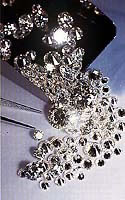 In the 1990s, however, several events occurred that have worked to endanger the company’s monopoly. The first was the collapse of the Soviet Union, the world’s second largest producer. When the Soviets discovered rich deposits in Siberia in 1958, De Beers persuaded the regime to sell its entire production to the CSO, preserving the company’s single marketing channel. With the disintegration of communism, however, it has become increasingly difficult for De Beers to control Russia’s supply. After a series of conflicts, an increasing percentage of Russian diamonds are now sold outside the CSO.
In the 1990s, however, several events occurred that have worked to endanger the company’s monopoly. The first was the collapse of the Soviet Union, the world’s second largest producer. When the Soviets discovered rich deposits in Siberia in 1958, De Beers persuaded the regime to sell its entire production to the CSO, preserving the company’s single marketing channel. With the disintegration of communism, however, it has become increasingly difficult for De Beers to control Russia’s supply. After a series of conflicts, an increasing percentage of Russian diamonds are now sold outside the CSO.
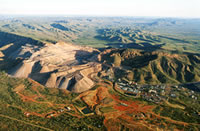 Second, the termination of Argyle diamond mine’s contract with De Beers reduced the company’s presence in the lower end of the market. Although most of the diamonds from Australia’s Argyle are poor quality, it is the largest mine, by volume, in the world. The breakaway of Argyle from the cartel significantly damaged De Beers’ control over the market.
Second, the termination of Argyle diamond mine’s contract with De Beers reduced the company’s presence in the lower end of the market. Although most of the diamonds from Australia’s Argyle are poor quality, it is the largest mine, by volume, in the world. The breakaway of Argyle from the cartel significantly damaged De Beers’ control over the market.
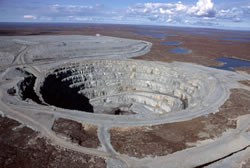 The third event was the discovery of several rich diamond mines in the Northwest Territories of Canada (Ekati, Diavik and Winspear). Although De Beers was able to secure 35 percent of the production of Ekati and launched a successful takeover of Winspear, it does not hold a dominant position in Canada.
The third event was the discovery of several rich diamond mines in the Northwest Territories of Canada (Ekati, Diavik and Winspear). Although De Beers was able to secure 35 percent of the production of Ekati and launched a successful takeover of Winspear, it does not hold a dominant position in Canada.
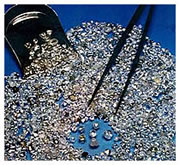 The excess supply from mines in Australia, Canada and Russia has led to rising competition in the mining of rough gems and erosion of the company’s monopoly. De Beers’ grip on market share has slipped from 80 percent in the early 1980s to about 65 percent in 2000. In an effort to keep prices high, the company was forced to hold back a large percentage of its diamonds and to purchase excess supply from its competitors at high prices. The traditional business model of controlling supply has proved to be costly, and it was inevitable that De Beers consider developing an improved strategy for competing with the new players.
The excess supply from mines in Australia, Canada and Russia has led to rising competition in the mining of rough gems and erosion of the company’s monopoly. De Beers’ grip on market share has slipped from 80 percent in the early 1980s to about 65 percent in 2000. In an effort to keep prices high, the company was forced to hold back a large percentage of its diamonds and to purchase excess supply from its competitors at high prices. The traditional business model of controlling supply has proved to be costly, and it was inevitable that De Beers consider developing an improved strategy for competing with the new players.
In addition, most antitrust regulations are becoming much stricter. The De Beers strategy, by U.S. law, is illegal. In 1945, the Justice Department initiated antitrust proceedings in New York against diamond cartel members. In 1994, the company was charged with colluding with the General Electric Company to raise prices. As a result, De Beers cannot directly deal with its largest market. Also, in Europe there is widespread speculation that the company will be a future target of EU antitrust efforts to break up dominant companies.

